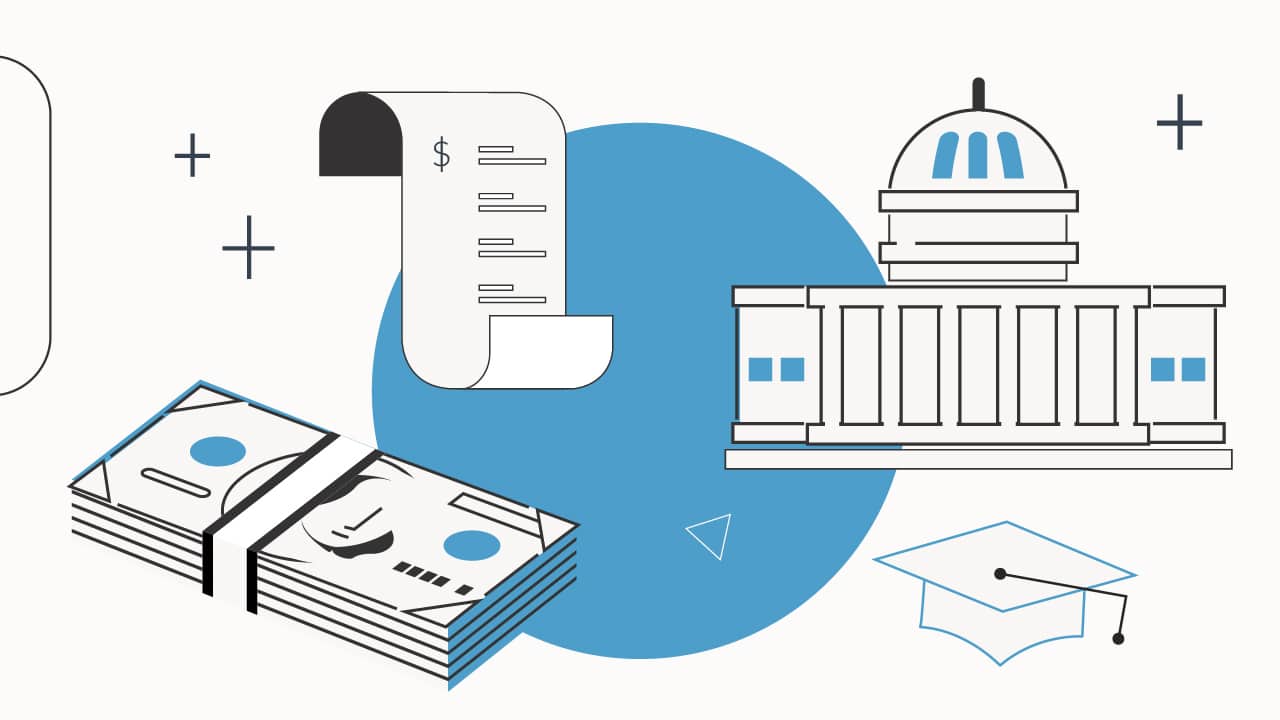
Source: The College Investor
The U.S. Congressional Budget Office (CBO) has issued new projections concerning federal student loan programs. These projections show increases in loan volume and decreases in interest rates. Overall, the CBO estimates that the federal student loan programs will not be profitable to the federal government, costing 20 cents to 26 cents per dollar lent, depending on the type of accounting method.
Annual student loan volume will increase due to an increase in the number of borrowers and an increase in the average amount borrowed per borrower.
Loan subsidy rates depend on the type of loan and the repayment plan. Income-driven repayment plans are much more expensive than repayment plans with a fixed term. The CBO projects that more than two-thirds of federal education loans will be repaid in income-driven repayment plans.
FCRA vs. Fair-Value Accounting
Estimates of the lifetime costs of a student loan are based on a net present value calculation, where future cash flows are discounted back to the present.
Net present value calculates how much money would need to be invested now with a rate of return equal to the discount rate, to replace the future payments on the loan.
Cash flows include amounts disbursed and amounts repaid, minus defaults and amounts discharged or forgiven.
The subsidy cost is then the difference between the net present value and the original amount disbursed. The "subsidy cost" is the dollar amount that taxpayers will pay for the program.
The CBO uses a methodology based on the Federal Credit Reform Act of 1990 (FCRA), which bases the discount rates on the rates on Treasury securities of comparable maturity. For example, cash flows two years from now would be discounted based on the two-year Treasury rate.
Fair-value accounting, on the other hand, uses a discount rate based on market value. This takes market risk into account, while FCRA does not. Fair-value accounting usually yields a higher discount rate than FCRA. A higher discount rate leads to a lower net present value for the future cash flows.
Critics of the federal student loan programs argue in favor of using fair-value accounting because it makes the federal student loan programs appear to be more expensive. Though, the federal government isn’t subject to the same market risk as private investors, so the discount rate under fair-value accounting is probably too high. Proponents of fair-value accounting are also selective in when they use of fair-value accounting, applying it only to programs that they do not favor instead of all programs. The valuations under fair-value accounting are more volatile than the valuations under FCRA, more subjective and more prone to manipulation.
In any event, the cost of the federal student program has increased significantly in recent years, regardless of whether one uses FCRA or fair-value accounting, because interest was waived during the payment pause, there was an increase in the number of borrowers qualifying for forgiveness and discharge, the student loan on-ramp delayed the restart of repayment, there was a shift in the distribution of borrowers among repayment plans, and there was a net change in the terms of repayment plans due to the introduction of the SAVE repayment plan.
This, in turn, affects the subsidy rates for federal education loans. It also affects the credit re-estimates and modifications, which measure cumulative subsidies.
Projected Student Loan Volume Increases
The CBO is projecting that annual federal student loan volume will increase from about $85.9 billion in FY2024 to $89.9 billion in FY2025, then growing by an average of $2 to $3 billion a year until it reaches $112.0 billion in FY2034. That’s an annualized increase of 2.7%.
The increase in aggregate federal student loan volume is due in part to an increase in the number of borrowers from 12.3 million in FY2024 to 12.5 million in FY2025, and eventually reaching 13.7 million in FY2034. That’s an annualized increase of 1.1%.
At the same time, the CBO expects the average loan amount to increase from $7,008 in FY2024 to $7,192 in FY2025 and eventually reaching $8,170 in FY2034. That’s an annualized increase of 1.5%.
These projections may be inaccurate. On an academic year basis, federal student loan disbursements have steadily decreased from $106.1 billion in 2011-12 to $76.7 billion in 2022-2023.
The CBO projections involve a reversal of this trend and an unusually large 12% one-year increase in loan disbursements.
Projected Subsidy Rates (FCRA)
The FY2024 subsidy rate for all federal education loans is 20.2%. This means that every dollar loaned by the federal government, on average, costs the federal government about 20 cents.
That is significantly higher than it was just prior to the pandemic, when it was 0.25%.
The CBO projects that the subsidy rate will decrease to 18.1% in FY2026 and then start increasing until it reaches 19.5% in FY2034.
The FY2024 subsidy rates vary by type of loan.
- Subsidized Undergraduate Loans: 34.8%
- Unsubsidized Undergraduate Loans: 27.2%
- Unsubsidized Graduate Loans: 18.9%
- Grad PLUS Loans: 24.8%
- Parent PLUS Loans: -16.5%
The negative number for Parent PLUS Loans means that the CBO calculates that the Parent PLUS Loans are profitable to the federal government under FCRA, yielding 17 cents per dollar lent, while the other loans have a net cost of 19 cents to 35 cents per dollar loaned.
Related: Why Parent PLUS Loans Are Barred From Most Repayment Plans And Forgiveness Options
Student Loan Costs For Fixed Repayment Plans
The FY2024 subsidy rates also depend on the repayment plan. For repayment plans with a fixed repayment term, the subsidy rates are:
- Subsidized Undergraduate Loans: 7.5%
- Unsubsidized Undergraduate Loans: -4.0%
- Unsubsidized Graduate Loans: -15.7%
- Grad PLUS Loans: -26.3%
- Parent PLUS Loans: -16.5%
So, except for the subsidized undergraduate loans, which waive interest during the in-school, grace and deferment periods, the fixed repayment term loans are profitable to the federal government.
Student Loan Costs For Income-Driven Repayment Plans
However, the FY2024 subsidy rates for loans in income-driven repayment plans are all positive, representing a net cost to the federal government.
The subsidy rates are:
- Subsidized Undergraduate Loans: 47.7%
- Unsubsidized Undergraduate Loans: 38.9%
- Unsubsidized Graduate Loans: 29.5%
- Grad PLUS Loans: 34.4%
A subsidy rate is not reported for Parent PLUS loans because few borrowers enroll in income-driven repayment plans, in part because of limited access to income-driven repayment plans.
The CBO projects that 68% of subsidized undergraduate loans will be repaid in an income-driven repayment plan in FY2025, 73% of unsubsidized undergraduate loans, 76% of unsubsidized graduate loans and 85% of Grad PLUS loans. Income-driven repayment plans will become the default choice (pun intended).
These projections may be affected by pending lawsuits that seek to block the SAVE repayment plan, as well as the Biden administration’s second attempt at broad student loan forgiveness.
Projected Subsidy Rates (Fair-Value Accounting)
Under fair-value accounting, the CBO estimates that the FY2024 subsidy rate for all federal education loans is 26.4%, 6.2 percentage points higher than the 20.2% subsidy rate under FCRA.
When disaggregated by type of loan, the FY2024 subsidy rates under fair-value accounting are:
- Subsidized Undergraduate Loans: 39.1%
- Unsubsidized Undergraduate Loans: 32.3%
- Unsubsidized Graduate Loans: 24.3%
- Grad PLUS Loans: 30.8%
- Parent PLUS Loans: -3.1%
So, the Parent PLUS Loans are still profitable under fair-value accounting, but much less so than under FCRA, -16.5% vs. -3.1%.
Under fixed repayment terms, the subsidy rate for unsubsidized undergraduate loans swings to a loss, 3.7%. The graduate and parent loans are less profitable. The subsidy rates also increase for the income-driven repayment plans.
Projected Interest Rates
The CBO is projecting that interest rates on federal student loans to undergraduate students will decrease from 6.53% in 2024-25 to 6.19% in 2025-26, dropping to 5.64% in 2027-28 and then increasing to 6.16% in 2034-35.
There are similar projections for federal student loans to graduate students and PLUS loans. The CBO projects that the interest rates on these loans will decrease from 8.08% and 9.08% in 2024-25, respectively, to 7.74% and 8.74% in 2025-26, dropping to 7.19% and 8.19% in 2027-28 and then increasing to 7.71% and 8.71% in 2034-35.
If the Federal reserve does lower interest rates later this year, it's reasonable to assume rates may be lower next academic year.
Final Thoughts
These updated projections show that the CBO expects the Federal student loan program to cost the Federal government more in future years. Prior to the pandemic, the government spent roughly $0.25 per every $100 loaned. Effectively, the Federal student loan program almost paid for itself.
However, with an increase in borrowers qualifying for loan forgiveness, higher non-payment rates due to various on-ramp programs, and major changes to student loan repayment plans, the CBO estimates that the government will end up spending $20 per every $100 loaned out.
That is an 80x projected subsidy increase in a rather short period of time.

Mark Kantrowitz is an expert on student financial aid, scholarships, 529 plans, and student loans. He has been quoted in more than 10,000 newspaper and magazine articles about college admissions and financial aid. Mark has written for the New York Times, Wall Street Journal, Washington Post, Reuters, USA Today, MarketWatch, Money Magazine, Forbes, Newsweek, and Time. You can find his work on Student Aid Policy here.
Mark is the author of five bestselling books about scholarships and financial aid and holds seven patents. Mark serves on the editorial board of the Journal of Student Financial Aid, the editorial advisory board of Bottom Line/Personal, and is a member of the board of trustees of the Center for Excellence in Education. He previously served as a member of the board of directors of the National Scholarship Providers Association. Mark has two Bachelor’s degrees in mathematics and philosophy from the Massachusetts Institute of Technology (MIT) and a Master’s degree in computer science from Carnegie Mellon University (CMU).
Editor: Robert Farrington Reviewed by: Colin Graves